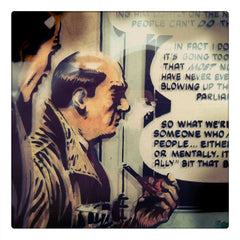V for Vendetta, 1982

The comic creates a world that is more than the sum of its parts.
V for Vendetta is an extremely popular comic book for good reason. The powerful story of freedom and identity is told through haunting visuals in stark black and white tinted with pastels.
The V for Vendetta stories first appeared in the British comic magazine Warrior, published by Quality Comics in 1982. It was one of the most popular titles in that magazine, and when Warrior was cancelled in 1985, several companies vied to publish the rest of the story. The comic was eventually reprinted by DC’s Vertigo imprint in 1988 and continued to completion.
Warner Brothers released a film based on the comic in 2006. Though the film tempers the comic’s anarchy and turns the lead character into a less ambiguous freedom fighter, it was still pretty successful, earning over a hundred million dollars worldwide.
In a twist of life imitating art imitating life, the main character, V – who dresses as Gunpowder Plot treasonist Guy Fawkes – has since inspired real-life protestors around the world to don Guy Fawkes masks in their demonstrations against oppression.
So what’s the secret of this book’s success, which has gripped readers since it first appeared over thirty years ago? According to writer Alan Moore, it’s the perfect blend of words and images. In an article from the comic’s original run in1983, he wrote that “V is something that happens at the point where my warped personality meets [artist David Lloyd’s] warped personality.” For Moore, that’s the secret to any comic; “what’s called for is teamwork, in the grand tradition of Hope and Crosby.”
A sentiment that the character V would probably agree with.